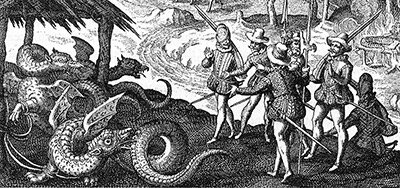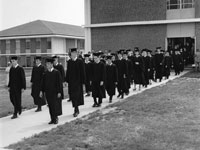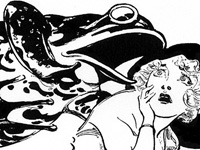1. "… the poisonous weede being in shape but little different from our English yuie, but being touched cause thrednesse, itchinge, and lastly blysters, the which, howsoever, after a while they passe away of themselves without further harme; yet because for the time they are somewhat painefull, and in aspect dangerous, it hath gotten to itselfe an ill name, although questionlesse of noe very ill nature." [1]
What was this plant?
Poison ivy (Rhustoxicodendron).
2. In 1620, Oppenheim printer Theodore de Bry published America, in which he richly illustrated part of The East and West Indian Mirror, a book published the previous year that narrated Georg Spielbergen's expedition in 1614-1617 around the world. The following is one of de Bry's illustrations, showing Europeans in the New World [2]:

What are the animals the men in the foreground are hunting?
Sea Lions (Otaridae).
3. In 1557 in Paris, Andre Thevet published, Singularities de la France Antarctique. It was translated into English and published the following year in London. It described and pictured some of the wildlife of Patagonia, present-day Argentina and Chile. One of the illustrations shows a "su," which Thevet said was "a ravenous beast made after a strange maner." [3]

What was this animal?
A kind of opossum. Specifically, the Elegant Fat-tailed Opossum (Thylamyselegans), native to Patagonia. Captain John Smith would later encounter a Virginia Opossum (Didelphisvirginiana) and describe it this way: "An Opassom hath an headlike a Swine, and a taile like a Rat, and is of the bignesse of a Cat. Under her belly she hath a bagge, wherein she lodgeth, carrieth, and suckeleth her young." [4]
4. Captain John Smith's General Historie of Virginia has the following passage:
"Plums there are of three sorts. The red and white are like our hedge plums, but the other which they call Putchamins, grow as high as a Palmeta: the fruit is like a Medler; it is first greene, then yellow, and red when it is ripe; if it be not ripe, it will draw a mans mouth awry, with much torment, but when it is ripe, it is as delicious as an Apricot." [5]
What is Smith describing?
Persimmons (Diospyrosvirginiana).
5. In 1530, Pietro Martire d'Anghiera, in his De Orbo Novo, wrote of the Indians of Hispaniola (present day Haiti and the Dominican Republic):
"They dygge also owte of the ground certeyne rootes growynge of theimselues, which they caule ____, much lykevnto the nauie rootes of Mylayne, or the greate puffes or musheroms of the earth. Howe sooeuer they bee dressed, eyther fryed or sodde, they gyue place to noo such kynde of meate in pleasant tenderness. The skyn is sumwhat towgher then eyther of nauies or musheroms, and of earthy coloure: But the inner meate thereof, is verye whyte. … They are also eaten rawe, and haue the taste of rawe chestnuttes, but are sumwhat sweeter." [6]
What goes in the blank?
"Botatas," that is, potatoes (Solanumtuberosum). This appears to be the first mention of potatoes in European literature.
6. Miguel de Asua and Robert French, in A New World of Animals: Early Modern Europeans on the Creatures of Iberian America, describe Christopher Columbus's voyages to the New World. Their account of Admiral Columbus's first voyage lists many of the strange flora and fauna that the excited explorer discovered. Their account has this passage:
"But his elated mood probably plunged at the view of what he describes as a 'serpent' seven feet long and one foot wide. The beast escaped and disappeared into a pool, but was speared by the Spaniards and afterwards recovered and skinned. The Admiral, always mindful of the curiosity of his sovereigns about the marvels of nature, set down in his log that he had ordered the skin to be salted and kept in store to be later presented to them. Despite the terrifying appearance of the animal, the newcomers eventually became used to its meat, which had a pleasant flavour." [7].
The following illustration shows the Spaniards hunting these creatures:

What were they?
Iguanas (Iguana iguana).
7. On January 9, 1493 during his first voyage to America, Columbus recorded in his ship's log that, while sailing toward the river he had named the Rio del Oro, he saw three mermaids near the island of Hispaniola. They "came up very high out of the sea." He had seen some before, near the coast of Guinea. He observed that these mermaids "were not as beautiful as they are painted, as in some ways they are formed like a man in the face." [8]
What were these "mermaids" that Columbus saw?
They were almost certainly manatees (Trichechusmanatus).
 True. Or at least, he is recorded as doing so in colonist Robert Beverley's 1705 The History and Present State of Virginia, today a major resource in early Virginian and colonial history. Beverley gives a full account of Pocahontas's story (though historians debate its accuracy). According to Beverly, in England,
True. Or at least, he is recorded as doing so in colonist Robert Beverley's 1705 The History and Present State of Virginia, today a major resource in early Virginian and colonial history. Beverley gives a full account of Pocahontas's story (though historians debate its accuracy). According to Beverly, in England, False. Upon coming to the throne in 1891—following the death of her brother, King Kalakaua—Queen Lili'uokalani appointed Victoria Ka'iulani Cleghorn, her half-Scottish half-Hawaiian niece, as Crown Princess of Hawaii. Born in 1875 and educated in the UK, Ka'iulani spent the latter part of her short life advocating for the restoration of her country's independence. She died of illness in 1899, at the age of 23—shortly after the U.S. officially annexed Hawaii. The Hawaiian royal line continues today, but Ka'iulani was the last princess appointed while the monarchy held political power.
False. Upon coming to the throne in 1891—following the death of her brother, King Kalakaua—Queen Lili'uokalani appointed Victoria Ka'iulani Cleghorn, her half-Scottish half-Hawaiian niece, as Crown Princess of Hawaii. Born in 1875 and educated in the UK, Ka'iulani spent the latter part of her short life advocating for the restoration of her country's independence. She died of illness in 1899, at the age of 23—shortly after the U.S. officially annexed Hawaii. The Hawaiian royal line continues today, but Ka'iulani was the last princess appointed while the monarchy held political power.  False. The imperial family objected to the opening of Japan—which had kept its borders largely shut to outsiders for centuries—to the U.S., but the imperial princess' marriage did not take place until several years after the shogun concluded a second treaty, this one with the first U.S. Consul General to Japan, Townsend Harris. The shogunate, essentially a monarchy made up of warrior-rulers, had long held the power of government in Japan, while the traditional monarchy of the imperial family had become largely ceremonial. However, the shogunate's agreeing to open the country to Westerners in the treaties of 1854 and 1858 created a political divide between supporters of the shogun and of the emperor; Kazunomiya's marriage to Iemochi in 1862 was meant to bridge this divide.
False. The imperial family objected to the opening of Japan—which had kept its borders largely shut to outsiders for centuries—to the U.S., but the imperial princess' marriage did not take place until several years after the shogun concluded a second treaty, this one with the first U.S. Consul General to Japan, Townsend Harris. The shogunate, essentially a monarchy made up of warrior-rulers, had long held the power of government in Japan, while the traditional monarchy of the imperial family had become largely ceremonial. However, the shogunate's agreeing to open the country to Westerners in the treaties of 1854 and 1858 created a political divide between supporters of the shogun and of the emperor; Kazunomiya's marriage to Iemochi in 1862 was meant to bridge this divide. To read Robert Beverley's full account of the life of Pocahontas, refer to pages 25-33 of his The History and Present State of Virginia
To read Robert Beverley's full account of the life of Pocahontas, refer to pages 25-33 of his The History and Present State of Virginia 






 The University of Georgia's
The University of Georgia's 
